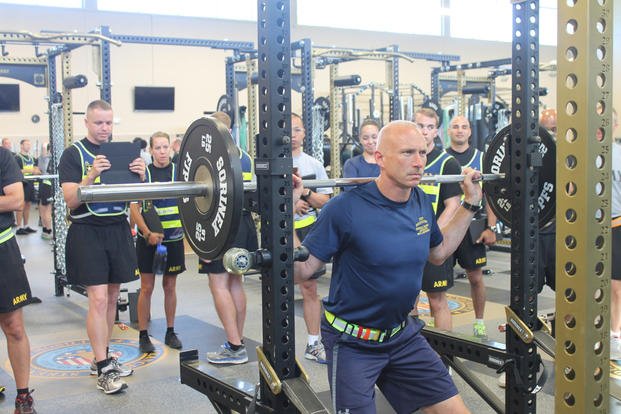If you choose a life of service to this country through the armed forces and law enforcement or as an EMT or firefighter, I thank you for your service.
As you know, this journey comes with bumps and bruises, disrupted sleep patterns and high stress. Here is a question from a police officer on how to balance a hectic work schedule and his fitness routine.
Hi Stew,
I am hoping you can help me with something body weight-based on my fitness into the next decade of 50 and over. I am a 52-year-old police officer (over 20 years), and my schedule between LE job and Reserve duties makes fitness routines challenging. I need to lose some weight but also pass the Army physical fitness test and the new Army combat fitness test eventually and score well -- personal pride. I like to run a bit, but my knees no longer like running so I have to mix that in sparingly. I tend to overdo running, lifting and PT, and get tendinitis issues mainly -- no major injuries. I am perpetually in seek of the "perfect plan" but maybe such a thing does not exist. I always got a bit bored with doing push-up and sit-up sets and then running, but exotic routines turn me off as well. Do you have suggestions for me? Thank you for your time and thank you for the articles on Military.com.
- Rob
Rob, I am with you. I just turned 50 myself this year and have a training age of nearly 40 years old. (I've been training since I was 10.) That comes with a lot of baggage, as does contact sports, competition, special-ops life and aging, all rolled into the same body. You sound like you have a similar training age and perhaps have not changed much of your training from what you did back in your 20s. I have a few new rules for you:
1. Evolve
You will be older for longer than you are younger in this life, as well as in your tactical professions. You must evolve your workouts. You do not have to give up and get weak, just evolve and realize your body does not react to the workouts you did 30 years ago like it used to.
2. Diet and weight loss
You cannot outwork your diet anymore. And if you want to lose weight, it must be coupled with diet (portion control mainly), avoiding sugar and drinking more water per day.
3. Consider periodization
Instead of completely dropping weights and running, try to cycle them through the year and work on muscle stamina/endurance phases, then speed phases. For my program (20th year of periodization), I lift in the fall and winter and run less -- ruck some and do calisthenics – and run more in the spring and summer. But with the 50-and-over rules below, I would consider at the most running every other day, especially if you have aches and pains associated with running and need to lose weight as well. Periodization allows for performance and recovery.
4. Running every other day
Unless you are not heavy, no pain involved and like running for competitions, running every other day will make sense. However, if you have significant weight to lose (250 pounds or more), I would not start running until you have lost most of that weight -- getting most of your cardio by walking, rucking (Army) and non-impact cardio options (bike, elliptical, row, swim).
5. Add in life-changing workouts
Stop doing what you did 20 to 30 years ago and thinking you will be fine. Do the fun things that got you into training in the first place, but change it up. You have to find what works for you, but by simply adding in one day to focus on non-impact cardio and mobility/flexibility, the result will be life-changing.
Adding a non-impact cardio day between running days is also life-changing. Yoga is a great option for not only the physical mobility/flexibility benefits but also for stress relief. Consider that. I like to add a mobility day once a week, but some weeks, I will do yoga or mobility training 2-3 times a week if sleep is disrupted, and I just need a low-impact/low-intensity movement workout to help de-stress.
An idea for body-weight spring/summer training: the Classic Military PT Week. It uses three classics: the PT pyramid, PT super set and the PT max-rep sets. All of the workouts are calisthenics-based, which will help you. The max-rep set workout may be tougher on the joints, so pull back from complete max-rep failure each set. There are more ideas at the Military Fitness pages, but also consider tactical fitness, as that is really what you are doing.
These workouts will help with PT tests, but if you want some more specific ideas on the Army PFT and Army CFT, check out the exercises and make sure they are added into your week. Or find a program that focuses specifically on those tests, as well as mobility, core work and rucking, too.
Stew Smith is a former Navy SEAL and fitness author certified as a Strength and Conditioning Specialist (CSCS) with the National Strength and Conditioning Association. Visit his Fitness eBook store if you’re looking to start a workout program to create a healthy lifestyle. Send your fitness questions to stew@stewsmith.com.
Want to Learn More About Military Life?
Whether you're thinking of joining the military, looking for fitness and basic training tips, or keeping up with military life and benefits, Military.com has you covered. Subscribe to Military.com to have military news, updates and resources delivered directly to your inbox.














